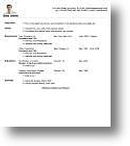Make a Good First Impression
All resumes are expected to look the same, more or less, and by using specific formatting this can be achieved. Nothing on your resume should be a distraction; when in doubt, follow these standard practices:
- Standard 8.5" x 11" paper is expected.
- Use a one-inch margin on all sides. It is imperative to have enough of a white border to make the document appear clean cut.
- Make sure to leave white space in between the various sections; nothing is more irritating to a recruiter than having to decipher multiple sections that are crammed together.
- Choose a standard, easy to read font like Times New Roman or Arial and black text. The average interviewer takes about 20 seconds to review a resume, so if the font is a distraction, or difficult to read they will move on to the next applicant.
- Different font sizes are required for each area on the resume. The top heading should be 16pt font, but the rest of the document (the body) should be 12pt.
Section Content
The next part is equivalent to body paragraphs in a letter. This section is where all the meat of the page lies. Entering as much information as you can without providing too many words is key. Try not to fill more than one page for your entire resume.
Most of the time the challenge of writing resumes isn't trying to fill them with content, it is keeping the content light enough to fit on one page.
- Contact information: This section is pretty simple, include all of your personal contact information, but be sure that it is all correct. Oftentimes people will make mistakes entering their own data and that is embarrassing! Read about social media and your employment search.
- Objective: Write in one sentence what type of job you are looking to obtain, this section is becoming obsolete. You could rename it and use it for something else.
- Skills: Be honest about your skills and do not neglect any certifications or machinery that you have been trained to operate. You never know what might catch an employer's eye.
- Education: Put your most recent or highest level of education first, with the degrees you have earned, and the internships or co-ops that you completed through your school.
- Experience: There is a very specific manner in which you must present your experience. Use keywords to align your education and experience with the job description.
The goal is to make it seem like your job is the most important position that anyone could ever have. Even if you work at something like answering telephones or waiting tables.
Here is the formula for describing your experience:
Interesting Title: Action verb (Manage), some numerical value (10) for the Duty performed, Frequency in which you performed it (daily.)
So, if you were a waitress, you could say something like:
Dining Server: Provide an elegant and enjoyable dining experience for 140-200 customers daily.
The interesting title grabs the reader's attention and makes the job sound more important. The action verb reinforces your work experience to increase its value. A numerical value puts an exact figure on your productivity at work, and the frequency at which you worked describes your work ethic to a potential future employer. - References: References are not included on your resume itself, but on a separate page instead. The references that you ultimately choose should be people for which you have previously worked, with whom you have made a good impression. People that are willing to rave about your great work are whom you want speaking about you.
Learning how to write a resume is easy once each section is broken down and explained, but there are certain pieces of information that can be left out because they aren't part of any one particular section. Using the following techniques can get you noticed and establish your good image to potential employers.
- Strategic Placement of Keywords: Companies are using software to scan your documents and digitally exclude ones that do not have the proper keyword saturation.
Research the company to which you are applying, and make sure that the words and phrases they are looking for appear in your document. This is true for your cover letter too.
A good strategy is to examine the job posting carefully. Pay attention to the requirements and any certifications requested, then make those visible on your page. - Addition of Action Verbs: Spice up your sentences with the help of action verbs. Strong verbs will communicate to the recruiter that you are passionate about your work.
- Proofread: One of the most important steps during any writing process is to proofread. Nothing makes you look more unprofessional than a misspelled word or an easy to find grammar mistake.
Beware of seemingly harmless mistakes like commas, apostrophes, and possessive nouns. In the world of grammar not having these mistakes demonstrates your proficiency and separates you from those who are less educated (qualified).
 The basic set-up of a resume is the most important aspect of writing because incorrect formatting can show up as a red flag to a recruiter. An employer may ignore the most qualified person because of simple mistakes.
The basic set-up of a resume is the most important aspect of writing because incorrect formatting can show up as a red flag to a recruiter. An employer may ignore the most qualified person because of simple mistakes.